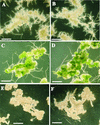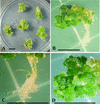Overexpression of Arabidopsis ESR1 induces initiation of shoot regeneration
- PMID: 11752375
- PMCID: PMC139476
- DOI: 10.1105/tpc.010234
Overexpression of Arabidopsis ESR1 induces initiation of shoot regeneration
Abstract
Functional screening of an Arabidopsis cDNA library enabled the identification of a novel cDNA, ESR1 (for Enhancer of Shoot Regeneration), that can confer cytokinin-independent shoot formation when overexpressed in Arabidopsis root explants. Neither callus induction nor root formation was affected by ESR1 overexpression. ESR1 encodes a putative transcription factor with an AP2/EREBP domain. Surprisingly, ESR1 overexpression also greatly increased the efficiency of shoot regeneration from root explants in the presence of cytokinin, with a shift in the optimal cytokinin concentration required for this process. The effects of ESR1 overexpression on shoot regeneration are synergistic with those of cytokinin. Overexpression of ESR1 cannot induce callus formation or root formation, suggesting that its effects are specific to shoot formation. In wild-type Arabidopsis plants, ESR1 expression was induced by cytokinin. ESR1 transcript levels also increased transiently during shoot regeneration from root explants, most probably in response to cytokinin in the shoot-inducing medium. This transient increase occurred after the acquisition of competence for regeneration and before shoot formation, which is consistent with the physiological effects of ESR1 overexpression. Our results suggest that ESR1 may regulate the induction of shoot regeneration after the acquisition of competence for organogenesis.
Figures







References
-
- Aoyama, T., and Chua, N.H. (1997). A glucocorticoid-mediated transcriptional induction system in transgenic plants. Plant J. 11, 605–612. - PubMed
-
- Chang, C., and Shockey, J.A. (1999). The ethylene-response pathway: Signal perception to gene regulation. Curr. Opin. Plant Biol. 2, 352–358. - PubMed
-
- Christianson, M.L., and Warnick, D.A. (1983). Competence and determination in the process of in vitro shoot organogenesis. Dev. Biol. 95, 288–293. - PubMed
MeSH terms
Substances
Associated data
- Actions
LinkOut - more resources
Full Text Sources
Other Literature Sources
Molecular Biology Databases
Research Materials
Miscellaneous

